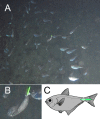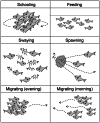Nighttime migrations and behavioral patterns of Pempheris schwenkii
- PMID: 34820179
- PMCID: PMC8603829
- DOI: 10.7717/peerj.12412
Nighttime migrations and behavioral patterns of Pempheris schwenkii
Abstract
Background: Although the biomass of the nocturnal fishes is almost same as that of diurnal fishes, most of the ecological studies that examine feeding or reproductive behaviors are on diurnal fishes. Therefore, there is limited ecological information regarding the nocturnal fishes. This fact may be attributed to the difficulty in observing them during darkness. Members of the genus Pempheris (Pempheridae) are one of the most abundant nocturnal fishes on coral reefs.
Methods: The nighttime migrations of Pempheris schwenkii were observed by attaching a chemical luminescent tag. Tagged fishes were followed by an observer without torch and SCUBA, and their positions and estimated depths were plotted on an underwater topographic map. Aquarium tank observation was carried out to further describe their habits during the night.
Results: The new tagging method provided good data for observing the migration behavior. In all five observations, the target fishes started nighttime migration from the entrance of their cave within 1 h after sunset. All of them immediately left the inner reef and spent most of the observation time near the surface (0-5 m depth) or shallow (5-15 m depth) water-columns of the outer reef. Their migration pattern varied between days, but they migrated long distance (379-786 m/h) during each observation. The behavior observed in the aquarium tank was categorized into five patterns: schooling, shaking, migrating, spawning, and feeding. Shaking and spawning were observed during one of three observation days.
Discussion: The present study firstly clarified the small-scale but dynamic nocturnal migration pattern of P. schwenkii in nature by a new method using chemical luminescent tags. In addition, combined observations from nature and an aquarium could be used to estimate the behavior of this species. Pempheris schwenkii may reduce their predation risk of eggs and adults by spawning at outer reef in nighttime. It was estimated that they can potentially migrate 4-7 km/night. The rapid growth known for this species may have been supported by their feeding behavior where they can fill up their stomach every night with rich zooplankton in outer reefs. Furthermore, the behavior of this species indicates the possibility that they make an important contribution to the flow of energy and materials in their coral reef ecosystem.
Keywords: Coral reef; Ecosystem; Feeding behavior; Keystone; Nocturnal; Observation; Pempheridae; Reproduction; Sweepers; Trophic link.
© 2021 Koeda et al.
Conflict of interest statement
Hideyuki Touma is employed by the Okinawa Churaumi Aquarium.
Figures





References
-
- Alldredge AL, King JM. Distribution, abundance, and substrate preferences of demersal reef zooplankton at Lizard Island lagoon, Great Barrier Reef. Marine Biology. 1977;41(4):317–333. doi: 10.1007/BF00389098. - DOI
-
- Annese D, Kingsford M. Distribution, movements and diet of nocturnal fishes on temperate reefs. Environmental Biology of Fishes. 2005;72(2):161–174. doi: 10.1007/s10641-004-0774-7. - DOI
-
- Bardach JE. On the movements of certain Bermuda reef fishes. Ecology. 1958;39(1):139–146. doi: 10.2307/1929976. - DOI
-
- Esquivel-Garrote O, Morales-Ramírez A. Nocturnal variation of the zooplankton community in coral reef substrates at Isla del Coco National Park (Eastern Tropical Pacific) Revista de Biología Tropical. 2020;68(1):S261–S270. doi: 10.15517/rbt.v68iS1.41189. - DOI
LinkOut - more resources
Full Text Sources
Research Materials

